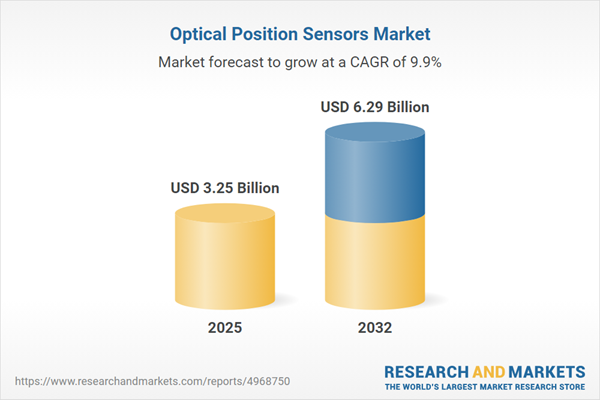Speak directly to the analyst to clarify any post sales queries you may have.
The optical position sensors market is a critical driver of industrial automation innovation, providing senior leaders with precise monitoring and enhanced process control for resilient performance across evolving manufacturing and operational landscapes.
Market Snapshot: Optical Position Sensors Market
Demonstrating steady, ongoing momentum, the optical position sensors market is backed by a solid compound annual growth rate and a positive global outlook. Widespread adoption has intensified within automation, robotics, healthcare, and aerospace as demand for high-accuracy and real-time measurement rises. Optical position sensors consistently deliver reliable results in production environments by enabling immediate operational adjustments. This capability supports organizations in navigating new industry standards and strengthening overall performance. Continuous design improvements increase accuracy and transparency for manufacturers, positioning these sensors as instrumental in global process optimization strategies.
Scope & Segmentation in the Optical Position Sensors Market
- Sensor Type: Contact optical position sensors support real-time, direct feedback in high-frequency motion applications. Non-contact variants are ideal in cleanroom and contamination-sensitive environments, where extended equipment longevity and minimal wear are essential.
- Technology: Optical encoders underpin precise motion control, especially valuable in robotics and sophisticated automation settings. Optical potentiometers leverage resistance-based feedback for ongoing regulation in various industrial operations. Reflective and through-beam sensors enable accurate distance and proximity detection, catering to requirements ranging from assembly to quality assurance.
- Output Type: Analog output optical position sensors are deployed when detailed gradient signal capture is necessary or when conditions are unstable. Digital output options facilitate seamless, instantaneous data communication, enabling integration within scalable, digitally unified automation infrastructures.
- Application: Usage extends across aerospace systems monitoring, advanced automotive manufacturing, electronics validation, medical device navigation, logistics, packaging automation, and robotics—signaling their indispensability across process-critical sectors.
- End Use Industry: Key verticals include aerospace, automotive, defense, electronics, and medical equipment. Here, optical position sensors help these industries maintain consistent compliance and continuous operational flow.
- Region: The market grows robustly in the Americas, Europe, Asia-Pacific, and the Middle East and Africa. Asia-Pacific leads in production acceleration, while digital modernization propels uptake in North America and Europe. Companies must navigate differing regulatory requirements and diverse operational conditions across global regions.
- Key Companies: Leaders such as Honeywell International Inc., TE Connectivity Ltd., and Infineon Technologies AG continually advance the sector through sensor miniaturization, increased integration, and adaptive partnership strategies to align with changing sector needs.
Key Takeaways for Senior Decision-Makers
- Optical position sensors enable consistent, transparent oversight of processes, leading to more robust manufacturing optimization and reduced downtime.
- Non-contact sensor designs extend asset lifespans and minimize contamination risks, a key requirement in highly regulated and sensitive production settings.
- Embedding optical position sensors within Industry 4.0 structures enhances predictive maintenance and supports flexible operational models through rapid adaptation capabilities.
- Digital output functionalities simplify real-time connectivity, expediting the implementation of automation across multiple sites and supporting business scalability.
- Ongoing innovation in sensor design, driven by strong industry collaboration, ensures that organizations remain well-positioned to deploy adaptable solutions and capitalize on automation trends.
- Strategic execution relies on managing compliance proactively and tailoring technology uptake to local market variations across different geographical regions.
Tariff Impact: Strategic Responses to Recent U.S. Actions
Recently imposed United States tariffs on optical and semiconductor components have increased material costs for sensor manufacturers. In response, organizations are broadening supplier networks, prioritizing regional sourcing, and building partnerships to reinforce supply chain continuity. Supplementary strategies include targeted domestic investments and refined inventory management, which ensure material availability and help maintain production pipelines amidst ongoing geopolitical developments.
Methodology & Data Sources
This report draws on insights from industry executives, technical experts, and verified third-party sources. It incorporates leadership interviews, benchmarking activities, in-depth sector reviews, patent evaluations, and consultation of prominent whitepapers, yielding actionable and substantiated market intelligence.
Why This Report Matters
- Equips senior decision-makers with the thorough analysis required to inform investment planning and resource allocation in the optical position sensors market.
- Offers clear, action-oriented guidance for adopting advanced sensing technologies while streamlining compliance with sector regulations.
- Supports executive teams in shaping successful automation transformation strategies and accelerating adoption of sensor-driven solutions across the organization.
Conclusion
Optical position sensors form the backbone of accurate measurement and advanced automation, allowing organizations to sustain competitiveness and strengthen operational resilience as industry demands evolve.
Additional Product Information:
- Purchase of this report includes 1 year online access with quarterly updates.
- This report can be updated on request. Please contact our Customer Experience team using the Ask a Question widget on our website.
Table of Contents
3. Executive Summary
4. Market Overview
7. Cumulative Impact of Artificial Intelligence 2025
Companies Mentioned
The companies profiled in this Optical Position Sensors market report include:- Honeywell International Inc.
- TE Connectivity Ltd.
- Infineon Technologies AG
- STMicroelectronics N.V.
- Texas Instruments Incorporated
- Broadcom Inc.
- ams OSRAM AG
- NXP Semiconductors N.V.
- Renesas Electronics Corporation
- Sensata Technologies Holding plc
Table Information
| Report Attribute | Details |
|---|---|
| No. of Pages | 198 |
| Published | October 2025 |
| Forecast Period | 2025 - 2032 |
| Estimated Market Value ( USD | $ 3.25 Billion |
| Forecasted Market Value ( USD | $ 6.29 Billion |
| Compound Annual Growth Rate | 9.8% |
| Regions Covered | Global |
| No. of Companies Mentioned | 11 |








